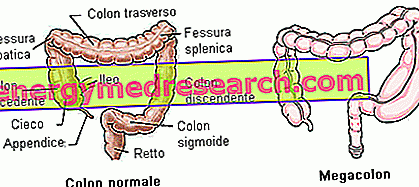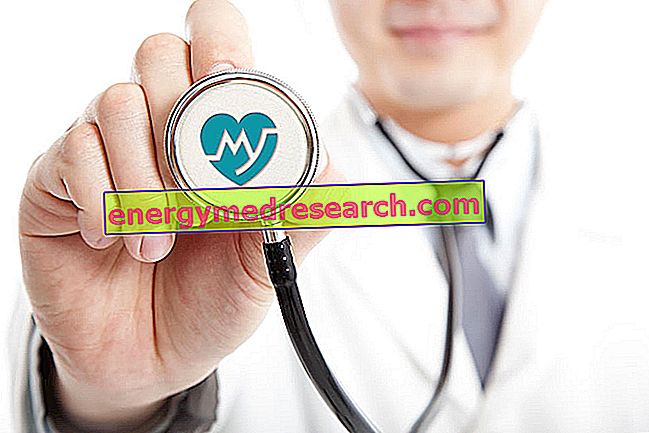Generality
The term megacolon identifies an abnormal distension that affects the entire colon or a specific portion of it. The causes can be congenital, therefore present since birth (Hirschsprung's disease), or acquired (megacolon is secondary to other pathologies, such as ulcerative colitis, infectious colitis, obstructions or intestinal sub-obstructions often resulting in obstinate constipation). Other times, excessive colonic dilation arises without any obvious cause (idiopathic megacolon) or is favored by drugs that reduce intestinal peristalsis - such as antidiarrheal, anticholinergics and narcotics - or by prolonged antibiotic therapies (this is the specific case of clostridium pseudomembranous colitis hard).
The gravity of the megacolon depends on its origins; the condition is extremely dangerous in acute-onset toxic forms, while it appears mild and easier to resolve in the event of partial obstruction resulting from chronic constipation.

Symptoms
When we talk about megacolon, we often only remember the symptoms associated with acute and toxic forms, including abdominal pain and distention, absence or scarcity of intestinal peristalsis and symptoms of systemic toxicity (such as mental confusion). In reality, given the wide spread of constipation, a modest colic distension is appreciable in many people, even in pediatric age. The emission of faeces of excessive hardness and size can be a characteristic sign of this mild megacolon condition: in addition to making the defecation difficult and painful, it tends to cause anal hyper-distension and consequent mucous cracking (fissures), accompanied by pain and traces of bright red blood in toilet paper. Especially in children, pain can lead to a vicious circle in which defecation is interpreted as a painful act, so that stimuli tend to be ignored and postponed by feeding constipation and favoring the appearance of chronic megacolon.
Hirschsprung disease
Hirschsprung's disease has an estimated incidence in one case every 5, 000 live births, and affects males four times more frequently than females. Although still unclear as regards origins, the disease appears to recognize an autosomal dominant component (given the tendency to manifest itself more frequently in some families).
It is characterized by developmental and maturation abnormalities of the Enteric Nervous System, also known as "second brain" or "gut mini brain". Due to the lack of rectal ganglia or rectum sigma, there is a reduction in peristalsis of the intestine. The affected tract is unable to relax and cause peristaltic movements, with slowing of the progression of enteric content and consequent distension.
The treatment of choice consists in the surgical resection of the intestinal segment.
Secondary Megacolon
We can distinguish toxic forms and non-toxic forms.
- ACUTE TOXIC MEGACOLON: it is a typical consequence of inflammatory bowel diseases (ulcerative colitis and more rarely Crohn's disease), toxic colitis or infectious colitis; the term "toxic" underlines the presence of symptoms of systemic toxicity (such as mental confusion) due to alterations of electrolytic homeostasis and acid-base balance.
- MEGACOLON NOT TOXIC: often consequent to obstruction or chronic mechanical subocclusion, common in case of obstinate constipation (in this case colic dilation is observed upstream of the obstruction).
Sometimes, although the signs, symptoms and radiological findings suggest it, it is not possible to identify the obstruction; is the case of Ogilvie's syndrome, typical of hospitalized patients and associated with a wide range of metabolic, pharmacological or post-operative conditions that suppress colon motility.
The treatment of these forms of megacolon aims to reduce distension of the colon to prevent perforation. This result is obtained by aspiration through a nasogastric tube and rectal probe. Feeding by mouth is suspended to prevent the introduction of air and food; it is then replaced by enteral nutrition, with particular attention to restoring the electrolyte balance to prevent shock and dehydration.
All diagnostic and therapeutic procedures must be performed with extreme care after assessing the risk of intestinal perforation; laxatives and evacuative enemas, for example, may be useful in preventing the appearance of megacolon from fecal impaction, but are contraindicated in the presence of toxic megacolon or severe acute distension.
Among the useful drugs in the presence of megacolon we recall:
- corticosteroids: may be useful to suppress the inflammatory reaction when the toxic megacolon is caused by the aggravation of an inflammatory bowel disease.
- Broad spectrum antibiotics: intravenously administered, they can be used to prevent sepsis or to treat a toxic megacolon dependent on Clostridium difficile infections
- Sometimes useful drugs that stimulate peristalsis (eg neostigmine, used in the case of Ogilvie's syndrome);
- Drug suspension that can reduce colonic motility (eg narcotics, antidiarrheal, anticholinergics, calcium channel antagonists)
In the presence of a particularly important distension subject to the risk of perforation, or in the case of failure of the therapies described above, surgical treatment of a more or less extensive part of the colon (colectomy) is required to resolve the megacolon.



